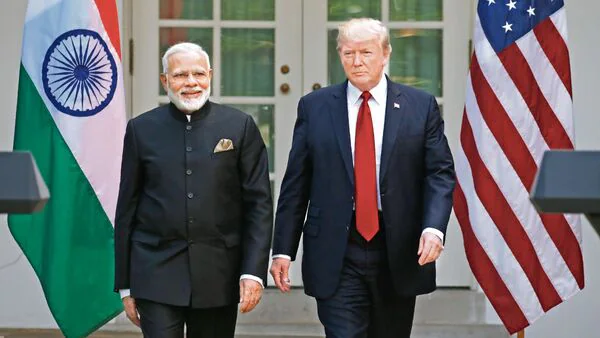Trump imposes additional 25% tariff on India: White House
US President Donald Trump on Wednesday imposed a 25 percent additional tariff on India, citing India’s continued import of Russian oil as a “threat to national security.” This move marks a significant escalation in trade tensions between the United States and India, and it is already sparking global reactions and policy debates.

According to the official executive order signed by President Trump, the additional tariff will take effect 21 days after its signing. However, goods already in transit between India and the United States will be exempt from this new tariff. Once in effect, the tariff will apply to all Indian products entering the US, without exception. The executive order explicitly references Executive Order 14066, which declared a national emergency in response to Russia’s actions in Ukraine.
“I find that the Government of India is currently directly or indirectly importing Russian Federation oil,” the order states. It further adds that these tariffs are “necessary and appropriate” to address the ongoing national emergency caused by geopolitical instability related to Russia’s actions.
Why the 25% Tariff?
The administration claims that India’s import of Russian oil threatens US national security, which is why the White House justified this additional 25% tariff. The government feels that India’s ongoing energy trade with Russia weakens the US-led position against Russia’s invasion of Ukraine and violates international sanctions. The White House stated unequivocally that this move is consistent with the US’s larger economic pressure strategy against Russia and its allies.
The executive order cautions that changes could be made to the order. According to the White House, the tariff order may be extended or modified in scope based on retaliatory measures or shifts in diplomatic affinities, whether by Russia or by other foreign governments impacted by the policy. This points to a flexible and continuous policy that will be strongly influenced by upcoming changes in international affairs.
Trump’s Earlier Threat and India’s Reaction
Earlier this week, President Trump had already issued a strong warning. He threatened to “substantially” raise US tariffs on India, citing what he described as India’s practice of buying massive amounts of Russian oil and reselling it for huge profits on the global market. This, according to Trump, not only boosts Russia’s economy indirectly but also hurts the integrity of Western sanctions against Moscow.
In response to this pressure, India mounted a sharp and assertive reply. On Monday, Indian authorities criticized both the United States and the European Union, labeling their stance on India’s Russian oil procurement as “unjustified and unreasonable.” India defended its energy policy, pointing out that every nation has the right to secure its own energy needs based on affordability and accessibility.
Furthermore, Indian officials highlighted what they called the “double standards” of the US and EU. India pointed out that both the US and European Union continue to maintain various forms of trade relations with Russia, even while urging other countries to stop. This argument gained some traction globally, especially among non-Western economies who view the Western sanctions as selectively enforced.
Strategic and Economic Implications
This 25% tariff could have major consequences for both the US and Indian economies. Indian exports to the US — including pharmaceuticals, textiles, engineering goods, and IT services — may now become less competitive due to increased prices in the American market. This move could also push India to look more seriously at other trade alliances, including BRICS+, ASEAN, and new regional trade blocs.
At the same time, US companies that rely on Indian imports could face higher operational costs, leading to downstream price increases for consumers. The broader trade and diplomatic relationship between the two countries, which had seen steady growth over the past decade, may now experience tension and slowdown.
US-India-Russia Triangle
The Russia-Ukraine war has led to a seismic shift in global alliances. While the US and EU imposed strict sanctions on Russia, India chose a neutral stance, continuing its long-standing energy and defense ties with Moscow. This neutral position has drawn criticism from the West, particularly from Washington.
However, India has argued consistently that its foreign policy is one of “strategic autonomy.” New Delhi has refused to be drawn into alliances that compromise its sovereignty or economic security. As part of this autonomy, India has taken advantage of discounted Russian oil, which has been a key factor in managing inflation and energy costs for its 1.4 billion citizens.
Now, with the US levying a 25% tariff on all Indian goods, citing national security, the situation becomes more complex. It puts New Delhi in a difficult position: balancing ties with Russia while maintaining strategic and economic relations with the US.
Could the Tariff Be Temporary?
There is still a possibility that the 25% tariff may not become a long-term policy. The White House noted that the order could be modified depending on developments. If India reduces its oil imports from Russia or engages in negotiations with the US regarding its energy trade, the tariff could be reversed or softened.
On the other hand, if India retaliates with its own tariffs or looks eastward to strengthen economic ties with China, Russia, or regional blocs, the confrontation could deepen. It would not be the first time that India and the US have clashed on trade issues, but this is certainly one of the more serious episodes in recent years.
Tariffs and Tensions
The announcement that Trump imposes additional 25% tariff on India, as confirmed by the White House, is a clear signal that Washington is ready to use economic tools to enforce its geopolitical agenda. Citing India’s continued import of Russian oil as a “threat to national security,” the executive order invokes Executive Order 14066, tying the issue directly to the national emergency declared over Russia’s war in Ukraine.
The 25% tariff, which takes effect in 21 days (excluding goods already in transit), applies to all Indian products entering the US. It is part of a broader strategic message from the US — either stop trading with Russia or face economic consequences.
India, for its part, has stood firm. It has called the move unjustified, pointed to Western hypocrisy, and reiterated its right to chart an independent energy and trade policy.
How this plays out will shape not only the future of India-US trade relations but also influence how the rest of the world responds to superpower pressure in a multipolar world.
Follow us for more news at Valleynewz.com

